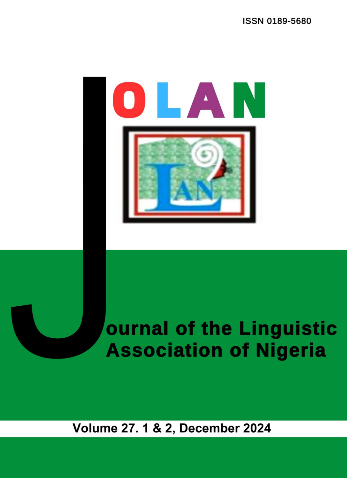The Language of Colour in Ibibio
Abstract
This paper discusses the semantic analysis of the language of colour in Ibibio. The theoretical framework adopted is the conceptual hypothesis as expounded by Goldman 1975 and Jackendoff 1990. The efficacy or otherwise of the use of colours as a veritable tool of communication (in Ibibio) is investigated. The data were collected from Central Ibibio. The conception of colours by different classes of people in different language environments is highlighted. The sample space for this study is carefully selected to enable the researcher answer such questions as: Does colour speak? Is the language of colour learned or acquired naturally? The instrument of interview approach is used to assemble the data. The analysis of the data so generated reveals that a simple colour may communicate different things to different people in different environments. Besides, the language of colour cannot be understood naturally but must be learned. The local languages/dialects covered by this study do not have word term for pink, brown, purple and grey. In both traditional and contemporary societies, colour at the traditional level speaks definite language whereas at the contemporary society, a simple colour may communicate different things to different people in different environments.
References
Anyanwu, H. O. and Appah, S. T. 2013. Colour symbolism in Ibibio Traditional Society. Reiko International Journal of Social and Economic Research (RIJSER), 4: 6.
Azikiwe, U. 2007. Language Teaching and Learning. Onitsha: Africana-First Publishers Limited.
Crystal, D. 1991. A Dictionary of Linguistics and Phonetics (enlarged edition). Oxford: Basil Blackwell.
Eka, D. and Udofot, I. 1996. Aspects of Spoken Language, Calabar: Bon Universal.
Goldman, N. 1975. Conceptual Generation. In: Schank, R., Conceptual Information Processing. Ed. Amsterdam: North-Holland, pp 289–371.
Jackendoff, R. 1990. Semantic Structures. Cambridge: MIT Press.
Lyons J. 2009. Language and Linguistics: An Introduction. Cambridge University Press, Cambridge.
Udofot, I. M. 1998. English Semantics. Uyo, Nigeria: Scholar’s Press (Nig.) Ltd.
Udofot, I. M. 2004. English Semantics, Uyo: Nigeria Scholar’s Press (Nig.) Ltd.
Wardhaugh, R. 1992. An Introduction to Socio-Linguistics.Oxford: Blackwell Publishers Ltd.
Willie, W. U. 2004. Pro-drop in Ibibio Questions. Ndimele, O. M. Ed. The Effects of Society Type and Language Use on the Survival of Culture. A Study of Ibibio Youths: A Festschrift for Okon Essien, Aba: National Insitute for Nigerian Languages, 919-938.














